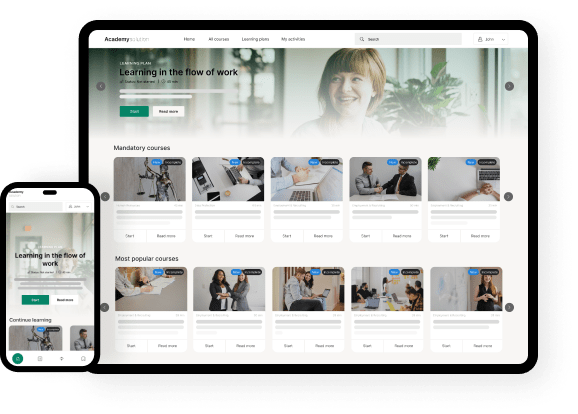Learning and development managers are often faced with the question of whether to develop their employees’ skills or competencies. But what exactly is the difference between those two?
The two terms are often confused and used interchangeably. However, it’s not quite right to say that “competency” is just a synonym of “skill.”
A useful rule of thumb is that skills are used to describe a job position, and competencies are used to explain how you fulfil a job role.
If you’re using an e-learning platform, it’s critical that you know the difference. Skills and competencies each play their own vital role in a talent management process and whichever you choose to focus on in your training program will hugely affect the process.
In this blog post, we’ll be focusing on how you run a competency-based training program through an e-learning platform or a so-called learning academy. We’ll help you exploit your digital platform in order to create a training program that’ll guarantee you success.
But first, let’s figure out what differentiates skills from competencies.
What are skills?
Skills are the abilities an individual has acquired through training, and which are essential to perform well in their job role. Depending on an employee’s specific role, skills can include computer programming, graphic design, and technical writing.
However, one must always distinguish between hard skills and soft skills. A hard skill is a technical and quantifiable skill that employees may demonstrate through their particular qualifications and professional experiences. A soft skill, on the other hand, is a non-technical skill that has less to do with a specific main occupation. For example, hard skills can be computer programming or SEO marketing, whereas soft skills may be time management or verbal communication.
You could say that skills determine the level of expertise an individual has and their capacity to manage deliverables.
What are competencies?
Competencies pertain to an individual’s knowledge and behavior which contributes to their job success. Examples of competencies include negotiation, strategic planning, and initiative.
Each competency an employee possesses illustrates how their behavior brings about the desired results in their role.
Just like skills, there exist different types of competencies. Most people possess both core competencies, cross-functional competencies, and functional competencies. As an example, core competencies play a key role in employees rising through the ranks of a company. As marketer Aja Davis Isble has explained it:
[…] a core competency is something that is core to you and how you work – so it is something that could potentially set you apart from every other candidate.
What is competency development?
E-learning platforms help organizations improve workforce growth and competitiveness through training and developing their employees.
Competency development pertains to the various measures used to increase the number of competencies within an organization. No matter if the occasion is recruitment, promotion, or employee mobility, such measures may include any activity that has the objective of promoting informal learning in the workplace.
Developing competencies can also be done through various HR training programs such as onboarding and compliance.
If you’re using a learning academy in developing workplace competencies, you should make sure you have a well-designed competency development plan that includes the following components:
- An employee competency checklist (e.g., business acumen, work ethic, problem-solving, communication skills)
- Clear and specific goals
- A list of competency or skills gaps
- A validation and revision scheme
How do you build a successful competency-based training program?
To build a successful competency-based training program, you must devote substantial time and resources.
A vital part of building your training program is to assess your company’s strengths and weaknesses as to find areas to improve on. However, make sure you’re not too caught up in your training program that you end up missing out on the many informal learning processes that happen in the normal day-to-day workflow.
Every corporate training program must have an intelligible framework. When talking about competency development, we refer to this framework as a competency development cycle.
A competency development cycle is a plan that guides administrators in managing and facilitating effective and efficient staff competency development. It’s a continuous cycle of action, reflection, and learning that enables an organization to:
- Identify strengths and development needs
- Create an action plan to engage staff effectively
- Support and monitor competency development progress
The rationale behind a competency development cycle is that employees are lifelong learners who have their own personal and collective journeys. Identifying the many differences in their learning journeys makes it easier to facilitate training and select the right tools.
Our best tips to succeed with competency development
Indeed, a well-defined competency development program begins with a comprehensive plan. But it may still take a considerable amount of effort and resources before the process brings you good results. Nevertheless, we have a few tips that’ll help you get a great head start:
Select competencies relevant to your organizational goals
Competencies are only relevant if they reflect your corporate goals and objectives. And sticking to competencies that don’t match your organization’s long-term plans may cease the development of your company. The first step is therefore to understand your company goals. Only then are you’ll be able to choose which competencies to develop.
Suppose your goal is to foster global and intercultural comprehension. In that case, you can initiate a seminar in which employees examine their personal cultural biases and address them through group sharing or dialogue with an expert.
Look for competency or skill gaps
The term “skills gap” refers to a fundamental mismatch between the skills that employees are expected to have and the ones they possess. This mismatch makes it difficult for individuals to excel in their chosen field and maximize their potential.
To identify these gaps, analyze your employees’ performance carefully. To gather useful data, you can start performing monthly employee assessments, manage KPIs, and provide 360-feedback sessions.
Define your need for developing competencies
It’s easy to fall down the rabbit hole, but you need to be true to your company and its goals. Do you in fact need to develop your employees’ competencies or are you just hopping on the bandwagon? Buying the newest innovation just to have it won’t provide you with any advantages if you don’t need it.
Before investing in a competency development program, you should therefore ask yourself the following questions:
- Is this investment based on a technological or functional need?
- Would this investment solve a specific issue or conflict?
- Are we developing competencies based on the desire to catch up with specific trends?
Keep the program straightforward but sustainable
Sustainability can be a huge problem when designing a competency development program. One issue that especially impacts your program’s continuity value is its degree of complexity. Complexities may be caused by:
- Poorly defined goals
- An attempt to go “big” in the beginning
- Lack of proper communication among key stakeholders
Remember, a development training program has many moving parts. People, resources, schedules, and other distractions can easily throw a wrench in the process. That’s why it’s crucial to make your program as straightforward as possible. Doing this will furthermore give you better opportunities to analyze every aspect of it.
A simple competency training plan focuses on these basic, yet essential elements:

Build your own learning academy with Cursum
Using digital platforms to optimize talent management processes is both innovative and lucrative.
As the world changes, your need changes. With a digital learning academy, it’s possible for you to quickly respond to sudden needs such as competency development.
With our learning academy, you can keep your employees updated on an everyday basis. But if you don’t have any employees to educate, but still possess knowledge within a specific area, you can use our platform to turn this into a digital product that you can sell to other businesses.
Contact us today to learn more about our services and learn how we together can transform your curiosity and knowledge into a profitable digital business.


